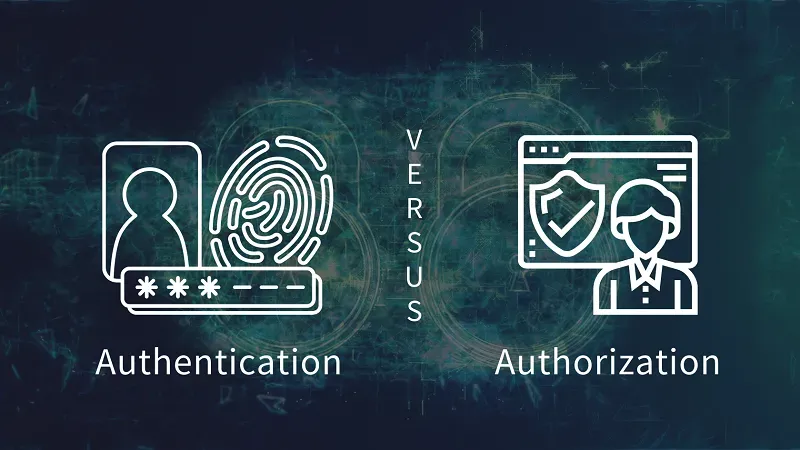Authentication vs Authorisation: What's the Difference?

Authentication and authorisation are the two most important network security parameters—often used interchangeably. However, they differ from one another. Both authentication and authorisation are necessary to deal with sensitive data security and protection against malicious online attacks.
Cybercriminal attacks and online threats are anticipated to cost up to $10.5 trillion annually by 2025—from just $3 trillion in 2015.
Such increasing risks of online attacks and the estimated costs associated with them lead to the growing need for secure remote access, strong authorisation, and Multi-Factor Authentication solutions within your organisation's security strategy.
This article compares authentication vs authorisation, highlighting the key differences between these two crucial security processes.
Authentication vs Authorisation
Authentication is the process of verifying the identity of a user or entity, whereas authorisation is the process of determining what resources or actions a verified user or entity is allowed to perform or access.
With the increasing frequency of cyberattacks, understanding the difference between authentication and authorisation and implementing robust methods for both is essential for maintaining data integrity and safeguarding an organisation's valuable assets.
What is Authentication?
Authentication is the method of verifying the user's identity. It simply verifies who the user is and whether they are who they claim to be.
An authentication example would simply be any password-protected website, platform, or application. If you enter the right password—it verifies your identity and grants you access to that specific website or platform.
Another example would be the identity and security check you need to go through at the airport before onboarding your flight.
However, of course, authentication can be compromised if you share your password or other critical credentials with other users–-which is why businesses incorporate Multi-factor Authentication Security, which we'll get into later.
What is Authorisation?
Authorisation is the process of determining what resources or actions a verified user or entity is allowed to access or perform within a system or application. It is the second step that follows authentication, where the user's identity has already been verified.
Authorisation ensures that authenticated users are granted appropriate access levels and permissions based on predefined rules and policies set by the organisation. It governs the "need-to-know" principle, limiting access to sensitive information and functionality to only those who require it for their roles and responsibilities.
Here are some differences between authentication and authorisation.
Authentication vs Authorisation
Authentication and Authorisation in Zero Trust Security Networking
The Zero Trust Network Security model is a modern security solution that replaces the traditional VPN technology and works on the principle of "Never Trust, Always Verify".
While VPNs protect network access, it allows universal and open access to the network resources and applications. The Zero Trust Network model, on the other hand, authenticates the user first and then provides authorised and trusted access to the users to specific applications.
Here are the benefits of Multi-Factor Authentication and authorisation when you implement it with your Zero Trust setup:
- Protects user accounts and prevents identity and credentials theft.
- Seamlessly works with hybrid workplaces by managing complex user access requests with ease.
- Simplifies authentication for users with a single-click and one-tap login—enhancing user experience.
- Protects weak user and employee passwords through Multi-Factor authentication.
- Strengthens security and reinforces secure login access across all applications.
Thus, the Zero Trust model and authentication work hand-in-hand to ensure strict access and security against cyberattacks and data breaches.
By understanding and implementing this clear difference between authentication and authorisation, organisations can enhance their security posture and mitigate the risks of unauthorised access and lateral movement within their networks.
Conclusion
Authentication and authorisation are two critical and distinct components of an organisation's access control system and security process. One is incomplete without another, and you need to implement both to preserve your network's credibility and integrity.
While authentication confirms and verifies user identities, authorisation can't grant access without knowing who the user is and what resources and applications they're allowed to access—working together as a single powerful security tool.
Therefore, if you wish to leverage these benefits and implement authorisation and user authentication, then check out our InstaSafe security solutions for your organisation. Our flexible and easily configurable Adaptive Multi-Factor Authentication provides smart and secure authenticated access with SSO and MFA for successful user verification and secure remote access. So, get in touch with us or book a demo to experience our Zero Trust services.
Key Products
Multi Factor Authentication | Identity And Access Management | ZTNA | Zero Trust Application Access | Secure Enterprise Browser
Key Features
Single Sign On | Endpoint Security | Device Binding | Domain Joining | Always On VPN | Contextual Access | Clientless Remote Access | Device Posture Check
Key Solutions
VPN Alternatives | DevOps Security | Cloud Application Security | Secure Remote Access | VoIP Security
